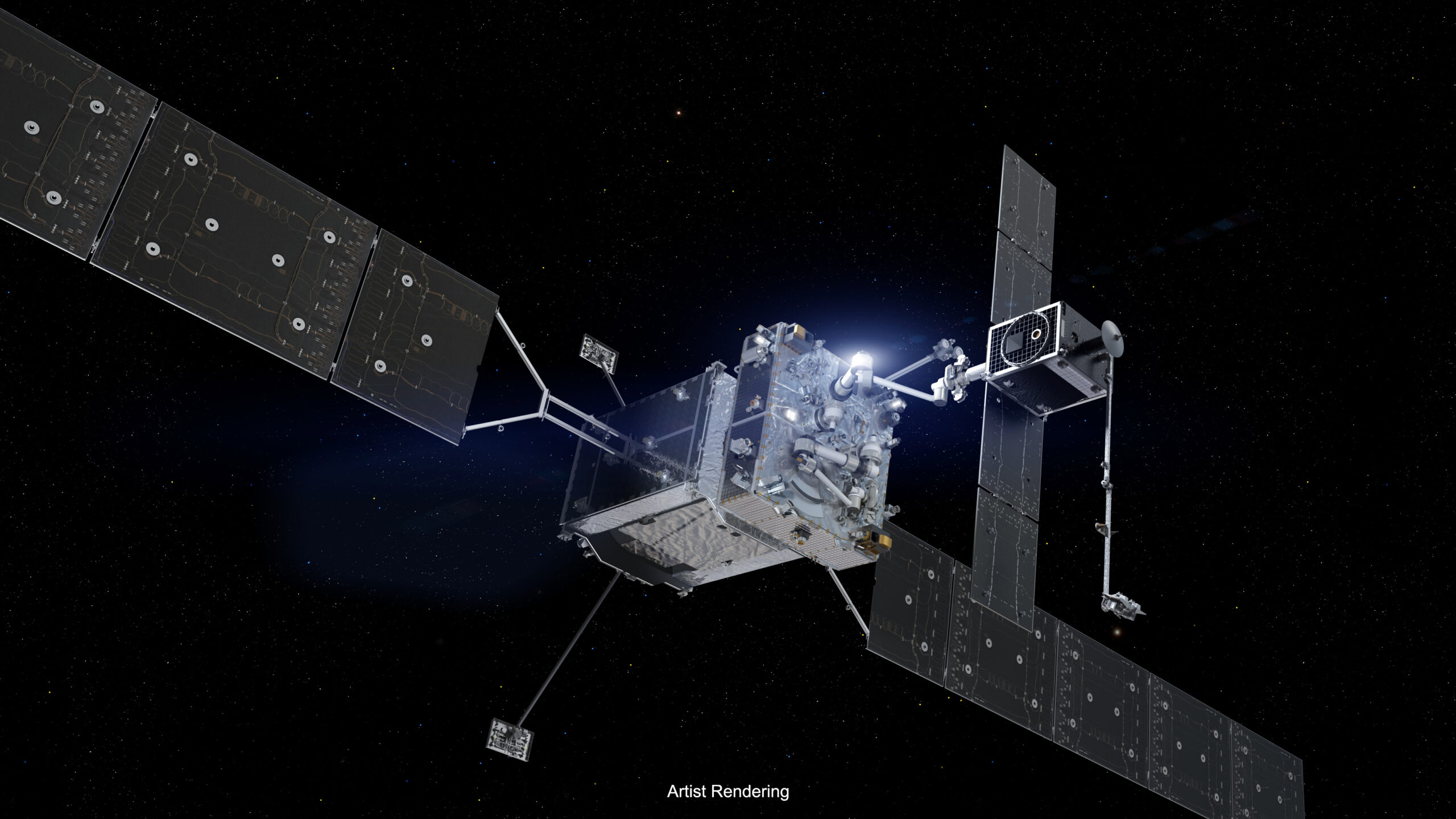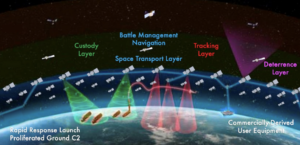
ORLANDO, Fla. — Following Northrop Grumman’s recent announcement that its satellite refueling port was selected as the preferred standard for military satellites, a Space Systems Command official said the company’s statement has been misinterpreted as making Northrop the sole provider.
A Northrop Grumman-designed refueling nozzle for satellites, known as the Passive Refueling Module, underwent a review by the Space Systems Command’s Space Systems Integration Office and was approved for use on high-value national security assets — but this does not represent a downselect, Col. Joyce Bulson, director of servicing, mobility and logistics, told reporters Jan. 31.
During a meeting with reporters at SpaceCom, an industry conference, Bulson insisted that the command continues to evaluate other refueling solutions for potential use.
She explained that Northrop Grumman’s Passive Refueling Module (PRM) was developed with government funding so it went through a specialized assessment as government-owned intellectual property. This led to its approval as a refueling standard for military satellites. However, Bulson stressed, this does not preclude adopting other commercially developed options.
Bulson’s comments suggest there was industry backlash after Northrop’s announcement led some to conclude it had won an exclusive monopoly, and that the selection of PRM could chill commercial investment and innovation.
Competition continues
To be sure, Northrop Grumman officials when discussing the announcement pointed out that the selection of the PRM was not exclusive.
The Space Systems Command intends to continue to promote competition in the industry, Bulson said.
“There is a refueling port, the PRM, and there are other refueling ports that we’re looking at and that we have on contract,” said Bulson.
The Space Systems Command’s Space Systems Integration Office reviewed the PRM and recommended it. “There isn’t anything particularly controversial with that,” she said. “But this is the first one that has gone through that boarding process because it is a government owned design.”
“We’re working with other partners to evaluate their designs and figure out what’s the best process to get those under review for the larger Space Force community,” Bulson added.
Acquisition strategy TBD
Bulson noted that many of the details about how the Space Force will procure refueling systems and services remain to be determined, as the service is still sorting through requirements documents and has yet to get funding approved for these efforts.
The selection of the PRM as a preferred interface for Space Force satellites suggests that the port would likely be used for the government’s most sensitive national security payloads. Because the government owns the IP, if other companies wanted to compete for refueling contracts they could conceivably seek the technical specs to build a compatible port.
Other refueling interfaces being developed in the commercial market, such as Orbit Fab’s RAFTI port, are being demonstrated in upcoming experiments, Bulson pointed out.
Orbit Fab’s CEO Daniel Faber told SpaceNews Jan. 31 that the company next month plans to ship 15 to 20 RAFTI ports to customers, and about half of the ports are for the U.S. Space Force.
“We passed design reviews,” he said. “We are shipping to the government for integration on government missions. Again, I’m confused on what exactly the PRM announcement means.”
Adam Harris, Orbit Fab’s chief commercial officer, said the company works with Northrop Grumman, which has invested in Orbit Fab.
“We’ve been working with them and their technology to make refueling happen,” Harris said. “One of the big things we’ve heard out of this conference is DoD really wants refueling, and we are encouraged by that.”
Regarding the selection of the RPM, Harris said, “I read the adjectives that were in the press release with a little bit of skepticism.”
- SEO Powered Content & PR Distribution. Get Amplified Today.
- PlatoData.Network Vertical Generative Ai. Empower Yourself. Access Here.
- PlatoAiStream. Web3 Intelligence. Knowledge Amplified. Access Here.
- PlatoESG. Carbon, CleanTech, Energy, Environment, Solar, Waste Management. Access Here.
- PlatoHealth. Biotech and Clinical Trials Intelligence. Access Here.
- Source: https://spacenews.com/space-force-seeks-to-clear-up-confusion-over-selection-of-northrop-grummans-refueling-tech/
- :has
- :is
- :not
- $UP
- 15%
- 20
- 31
- a
- About
- added
- Adopting
- After
- again
- an
- and
- Announcement
- anything
- approval
- approved
- ARE
- AS
- assessment
- Assets
- At
- BE
- because
- been
- being
- BEST
- Big
- Bit
- boarding
- build
- but
- by
- ceo
- chief
- clear
- comments
- commercial
- commercially
- community
- Companies
- company
- Company’s
- compatible
- compete
- competition
- conclude
- Conference
- confused
- confusion
- continue
- continues
- contract
- contracts
- controversial
- could
- Customers
- Daniel
- demonstrated
- Design
- designs
- details
- determined
- developed
- Director
- discussing
- documents
- DoD
- does
- efforts
- encouraged
- evaluate
- exactly
- Exclusive
- experiments
- explained
- Figure
- First
- fla
- following
- For
- Force
- funding
- get
- gone
- Government
- had
- Half
- happen
- Have
- he
- heard
- How
- However
- HTTPS
- if
- in
- industry
- Innovation
- integration
- intellectual
- intellectual property
- intends
- Interface
- interfaces
- invested
- investment
- IP
- IT
- ITS
- Jan
- jpg
- known
- larger
- Led
- likely
- little
- logistics
- looking
- make
- Making
- many
- Market
- means
- meeting
- Military
- mobility
- module
- Month
- most
- National
- national security
- next
- noted
- of
- Office
- Officer
- official
- officials
- on
- ONE
- Options
- Orbit
- Other
- out
- over
- owned
- owns
- particularly
- partners
- passed
- passive
- plans
- plato
- Plato Data Intelligence
- PlatoData
- ports
- potential
- preferred
- press
- Press Release
- process
- procure
- promote
- property
- provider
- Read
- really
- recommended
- Refueling
- release
- remain
- represent
- Requirements
- review
- reviewed
- Reviews
- s
- Said
- satellite
- satellites
- security
- Seek
- Seeks
- selected
- selection
- sensitive
- service
- Services
- servicing
- she
- ship
- Shipping
- Skepticism
- So
- Solutions
- some
- Space
- Space Force
- SpaceNews
- specialized
- specs
- standard
- Statement
- Still
- Strategy
- such
- suggest
- Suggests
- sure
- Systems
- tech
- Technical
- Technology
- that
- The
- their
- Them
- There.
- These
- they
- things
- this
- those
- Through
- to
- told
- u.s.
- U.S. Space Force
- under
- underwent
- upcoming
- use
- used
- wanted
- wants
- was
- we
- went
- were
- What
- which
- will
- with
- Won
- working
- works
- would
- yet
- zephyrnet










